What's In A Name?
Posted by 1st Chinese Herbs on Jun 6th 2016
We get calls all day here at 1st Chinese Herbs and at times, the questions are difficult to figure out. For example, someone called in and asked if we had "whortleberry," or "hurtle berry." We had no idea what this name was referring to, so we asked for a botanical name. The botanical name was Vaccinium myrtillus, which we can identify as bilberries. Without the botanical name, we would have not known which herb we were looking for.

Another example of how important botanical names are is sarsaparilla root with the botanical name of Hemedesmus indicus. But wait! There is another sarsaparilla root, with the botanical name of Smilax medica. The two different sarsaparillas have different properties. This is why it is so important to know the botanical name. Many times, the common name just isn't enough. The botanical name gives us a reference point so that we may cross reference to ensure you are getting exactly what you need.
Confused enough yet? Don't worry! We have a Common Names of Herbs Chart to make your life a bit easier. It includes the botanical name, the common names, and the Pin Yin names.
At times, what herb (plant) part is to be use may be even more important than the name is. For example, the lotus plant has several parts which can be used:
- Lotus Root
- Lotus Root Node
- Lotus Plumule
- Lotus Seed
- Lotus Leaf
- Lotus Stamen
It can become confusing to say the least, so it is always best to discuss with your doctor which herb and part of the herb you need. Don't worry, though! We have a page describing the Parts of Plants Used if you need some more information.
1st Chinese Herbs
Sharing the wealth of good health because you come first!

